ISSN ONLINE(2319-8753)PRINT(2347-6710)
ISSN ONLINE(2319-8753)PRINT(2347-6710)
S.Chakraborty 1, S.P.Mukherjee 2, S.Chakrabarti 3, B.C.Chattopadhyay 4,
|
| Related article at Pubmed, Scholar Google |
Visit for more related articles at International Journal of Innovative Research in Science, Engineering and Technology
The quality of a flexible pavement depends on the strength of its sub-grade soil. The strength of sub-grade is the major parameters for determining the thickness of pavement. In case of the flexible pavement the sub-grade must be uniform in terms of geotechnical properties like shear strength, compressibility etc. Materials selected for use in the construction of sub-grade must have to be of adequate strength and at the same time it must be economical for use. In view of the above the present investigation has been carried out with easily available materials like lime and rice husk ash mixed individually and also in combination with locally available clayey soil in different proportions at optimum moisture content (OMC). Since CBR is an important criterion in flexible pavement design, the strength improvement has been found in terms of CBR in the present study. The laboratory test results shows marked improvement of strength of soil with the addition of admixtures in respect of California Bearing Ratio (CBR) in unsoaked and soaked condition
Keywords |
| Sub-grade, Lime, Rice Husk Ash, MDD, OMC, CBR |
INTRODUCTION |
| India has a road network of more than 33 lakhs km which is the second largest road connecting system in a country in the world. About 65% of freight and 80% of passenger traffic are carried by the roads. Roads are one of the strongest measures of economic activity and the development of any nation. The quality of a flexible pavement depends on the strength of its sub-grade. The sub-grade acts as a support for the entire pavement system. In case of the flexible pavement the sub-grade must be uniform in terms of geotechnical properties like shear strength, compressibility etc. Materials selected for use in the construction of sub-grade must have to be of adequate strength and at the same time it must be economical for use. If the natural soil is very soft and weak it needs some improvement for use as sub-grade. It is, therefore, needed to stabilize the existing weak soil to achieve increased strength and reduced compressibility. |
RELATED WORK |
| A number of researchers have worked in this field for the last few years. Some salient works are as follows; Ramasubbarao et al (2013) developed a model to predict the soaked CBR value of sub-grade soil with the simple soil parameters with the help of multiple regression analysis. This statistical analysis indicates the better performance can be obtained from the model. The prediction of soaked CBR value be expressed as |
| CBRs = 0.064F+0.082S+0.033G-0.069LL+0.157PL-1.81MDD-0.061OMC |
| Biswas et al (2012) investigated the effects of adding RHA and lime in sub-grade of a rural road. They conducted that RHA can be effectively utilised for back filling and making sub-grade of roads. Their results showed that little addition of lime with RHA can significantly improve the engineering properties of weak sub-grade soil. Sabat et al (2010) investigated the effects of randomly distributed polypropylene fibre on engineering properties of expansive soil stabilised with RHA and Lime. The experimental results showed that in addition of fibre with RHALime stabilised soil MDD goes on decreasing and OMC goes on increasing. Roy et.al [3] examined the effect of mixing of Rice Husk (RH) with soil in different percentages to be used as sub-grade materials. Test results of cured samples indicated the similar trends as that of uncured samples. However curing for 30 days shows improvement of soaked CBR compared to that of uncured samples for any proportion of RH. Okafor et al(2009) performed laboratory experiments to study the effects of RHA on some geotechnical properties of a lateritic soil to be used for sub-grade. The test result showed that RHA increased the OMC but decreased the MDD of the soil. The addition of RHA improved the strength property (CBR) of the soil. The 10% RHA content was observed to be the optimum content for the lateritic soil. Alhassan (2008) carried out extensive laboratory experiments to investigate the effect of lime and RHA on permeability and strength properties of lateritic soils. Effects of the ash on the soil lime mixtures were investigated with respect to Unconfined Compressive Strength (UCS) and coefficient of permeability. His findings indicate that no more than 6% RHA can be used to increase UCS and reduce permeability of lateritic soil. From outcome of the above studies the present investigation has been done to gain an insight in to the effect of the strength improvement of soft sub-grade with the lime and rice husk ash. The major parameter for determining the improvement of soil is California Bearing Ratio under soaked and unsoaked conditions at the optimum moisture content. In view of this the present investigation has been carried out with easily available materials like lime and rice husk ash mixed individually and also in combination with locally available clayey soil in different proportions at corresponding optimum moisture content (OMC). The laboratory test results show marked improvement of strength of soil on addition of admixtures in terms of California Bearing Ratio (CBR). |
MATERIAL USED |
| The materials used in the present investigation were Rice husk ash, hydrated lime and locally available soft soil. The physical properties of these materials are summarized in the following sections. a) Soil: The soil used for this study was collected from Bidhannagar in Kolkata Municipal Corporation area in West Bengal, India at a depth of 2.5 to 3.5 m below the ground level using the method of disturbed sampling. The engineering properties of the soil used in this study are giving in table 1. b) Lime: The lime used in this study was obtained from the local market near the Jadavpur University. Generally hydrated lime is used for this works. The constituents of Hydrated lime with per-cent by weight as shown in table 2 c) Rice Husk Ash (RHA): Rice husk ash is basically agricultural waste products obtained from the rice milling. Rice milling generates a by product know as husk. During milling of paddy about 78/% of weight is received as rice, broken rice and bran, and rest 22% of the weight of paddy is received as huskThis was obtained from local rice mill at the Bashirhat sub division in North 24Parganas District. The RHA was ground and sieved through 0.075 mm aperture before use. The oxide composition of RHA is shown in table 3. |
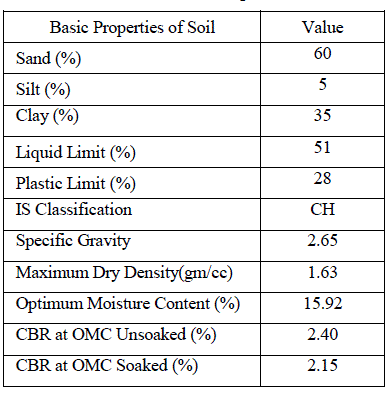 |
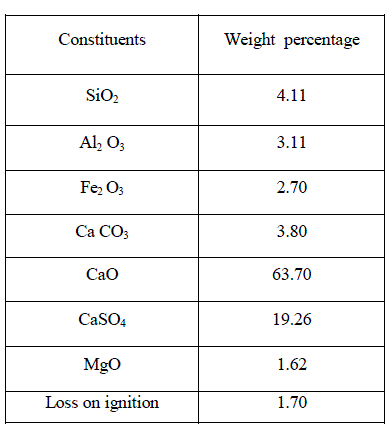 |
METHODOLOGY AND TEST PROGRAMME |
| All the tests of soil before and after stabilization with different mixtures of RHA and lime were carried out as per the Indian standard. For laboratory tests specimens of soil with and without admixtures were prepared by thorough mixing the required quantity of soil and stabilizers in pre-selected proportions in dry state and then required quantity of water was added and mixed thoroughly to get a homogeneous and uniform mixture of soil and admixtures. To maintain the homogeneity and uniformity of mix proportions, the California Bearing Ratio tests were performed under both soaked and un-soaked conditions, so as to ensure uniformity in proportion of materials and water content. The 2%, 4%, 6%, 8%, 10% proportions were used in cases of lime and 3%, 6%, 9%, 12% for RHA. They were mixed with original soil individually and also in combination of both the admixtures. |
LABORATORY TEST RESULTS |
| The laboratory test results for different parameters of Soil-Lime-RHA mixture are presented in table 4. |
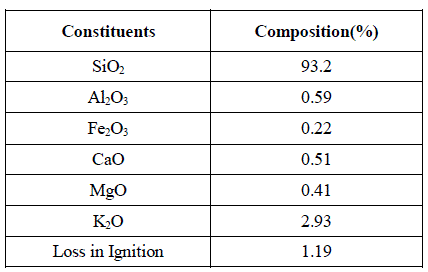 |
RESULTS AND DISCUSSION |
| The different properties of soil like Liquid Limit and Plastic Limit, Maximum Dry Density and Optimum Moisture Content and California Bearing Ratio are obtained after carrying out tests and different change of these soil properties with addition of admixtures are studied as follows: |
| A) ATTERBERG LIMITS: LIQUID LIMIT (LL) AND PLASTIC LIMIT (PL) |
| The results of Atterberg Limits tests on the clayey soil with the different percentage of lime and RHA are shown in Table.4. The nature of changes of liquid limit and plastic limit with the different percentage of lime and RHA also presented in Fig.1 and Fig.2. There is a general trend of decrease of liquid limit with the increase of lime percent for a particular RHA percent. The plastic limit has been plotted against percentages of lime in Fig.2 for different percentages of RHA. The figure shows a general trend of increase of plastic limit with the increase of lime per-cent up to 6% and beyond that that it is more or less constant or decreasing in nature for all rice husk ash contents. This is attributed to the fact that the rice husk ash has pozzolanic reaction with the lime from compound possessing cementatious properties of calcium silicate cement with the soil particles. |
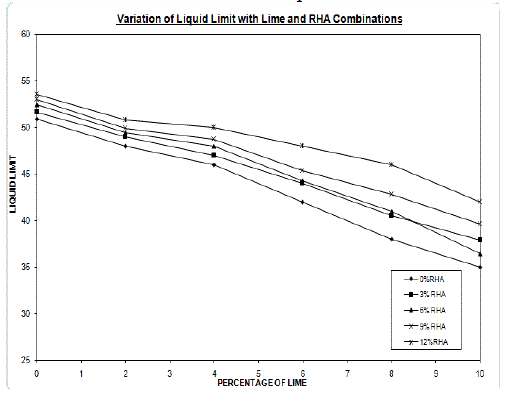 |
| B) MAXIMUM DRY DENSITY (MDD) AND OPTIMUM MOISTURE CONTENT (OMC) |
| The variation of maximum dry density with the different percentages of lime for different RHA combinations as shown in Fig. 3 and that for MDD is shown in Fig. 4.The Maximum Dry density generally decreases with increasing lime content for a fixed RHA content. For a fixed percentage of lime the value of MDD decreases with increase of RHA percentage. The decreasing trends in maximum dry density can be attributed to the cationic exchange of the lime which induces flocculation and agglomeration of clay particles. The Optimum Moisture Content generally increases with increasing lime content for a fixed RHA content.OMC increases with increase of RHA per cent for a fixed % of lime. The increase in OMC is due to the additional fine contents, which requires more water in addition to the free lime that needed more water for pozzolanic reactions. This occurs in spite of the reduced surface area caused by the flocculation and agglomeration. |
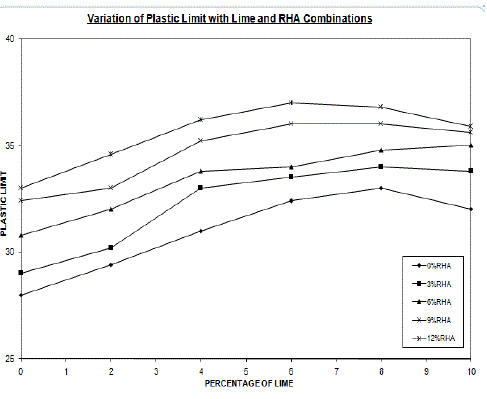 |
| C) CALIFORNIA BEARING RATIO (CBR) |
| The results of California Bearing Ratio tests on the clayey soil with the various mix proportions of RHA and lime both in soaked and Unsoaked conditions as shown in Table.4. The different changes of CBR values with different mix proportions in soaked and Unsoaked conditions are also presented in fig. 5 and fig.6. The CBR value increase with the increase of lime and RHA percentage. The maximum CBR value of 28% is found to occur for combination of 6% of lime and 9% RHA contents under un-soaked condition and the maximum value increases to 30% for 6% of lime and 6% RHA combination under soaked condition. The CBR value is found to increase appreciably with addition of RHA at lower lime content. |
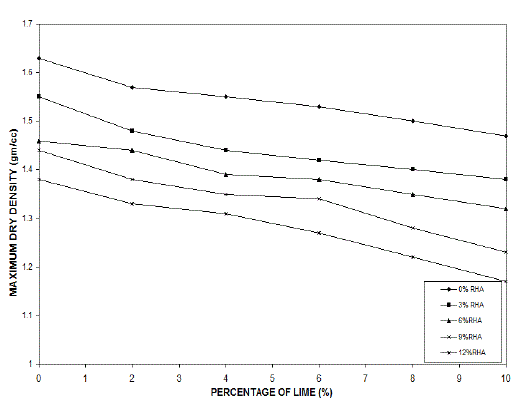 |
CONCLUSION |
| The following conclusions may be drawn from the present investigation on the basis of the laboratory test results of lime-RHA stabilised with the soft clayey soil: |
| i) The RHA can utilise as an alternative or a partial replacement of lime in stabilising the soft soil which is reduces the construction cost particularly in rural areas in West Bengal. |
| ii) The addition of admixture with the soft sub-grade decreases the Maximum Dry Density and increases the Optimum Moisture content. |
| iii) The treatment of soil with the addition of admixture such as lime and RHA has a general trend of decrease in liquid limit and increase in plastic limit and decrease of plasticity index. |
| iv) The soil used in this study, classified by the IS method is of clay of high plasticity(CH).The value of unsoaked and soaked CBR at the optimum moisture content is about 2.40% and 2.15%.Hence the soil is required for stabilised before the construction of flexible pavement. |
| v) This soil can be used as a sub-grade material when stabilised with 6% lime + 6% RHA. |
| vi)The value of unsoaked and soaked CBR improve appreciably as compared with the original soil. |
References |
|